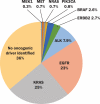Multi-institutional Oncogenic Driver Mutation Analysis in Lung Adenocarcinoma: The Lung Cancer Mutation Consortium Experience
- PMID: 25738220
- PMCID: PMC4410843
- DOI: 10.1097/JTO.0000000000000516
Multi-institutional Oncogenic Driver Mutation Analysis in Lung Adenocarcinoma: The Lung Cancer Mutation Consortium Experience
Abstract
Introduction: Molecular genetic analyses of lung adenocarcinoma have recently become standard of care for treatment selection. The Lung Cancer Mutation Consortium was formed to enable collaborative multi-institutional analyses of 10 potential oncogenic driver mutations. Technical aspects of testing and clinicopathologic correlations are presented.
Methods: Mutation testing in at least one of the eight genes (epidermal growth factor receptor [EGFR], KRAS, ERBB2, AKT1, BRAF, MEK1, NRAS, and PIK3CA) using SNaPshot, mass spectrometry, Sanger sequencing+/- peptide nucleic acid and/or sizing assays, along with anaplastic lymphoma kinase (ALK) and/or MET fluorescence in situ hybridization, were performed in six labs on 1007 patients from 14 institutions.
Results: In all, 1007 specimens had mutation analysis performed, and 733 specimens had all 10 genes analyzed. Mutation identification rates did not vary by analytic method. Biopsy and cytology specimens were inadequate for testing in 26% and 35% of cases compared with 5% of surgical specimens. Among the 1007 cases with mutation analysis performed, EGFR, KRAS, ALK, and ERBB2 alterations were detected in 22%, 25%, 8.5%, and 2.4% of cases, respectively. EGFR mutations were highly associated with female sex, Asian race, and never-smoking status; and less strongly associated with stage IV disease, presence of bone metastases, and absence of adrenal metastases. ALK rearrangements were strongly associated with never-smoking status and more weakly associated with presence of liver metastases. ERBB2 mutations were strongly associated with Asian race and never-smoking status. Two mutations were seen in 2.7% of samples, all but one of which involved one or more of PIK3CA, ALK, or MET.
Conclusion: Multi-institutional molecular analysis across multiple platforms, sample types, and institutions can yield consistent results and novel clinicopathological observations.
Figures


References
-
- Lynch TJ, Bell DW, Sordella R, et al. Activating mutations in the epidermal growth factor receptor underlying responsiveness of non-small-cell lung cancer to gefitinib. N Engl J Med. 2004;350:2129–2139. - PubMed
-
- Paez JG, Janne PA, Lee JC, et al. EGFR mutations in lung cancer: correlation with clinical response to gefitinib therapy. Science. 2004;304:1497–1500. - PubMed
-
- Soda M, Choi YL, Enomoto M, et al. Identification of the transforming EML4-ALK fusion gene in non-small-cell lung cancer. Nature. 2007;448:561–566. - PubMed
Publication types
MeSH terms
Substances
Grants and funding
LinkOut - more resources
Full Text Sources
Medical
Molecular Biology Databases
Research Materials
Miscellaneous

